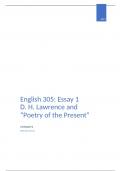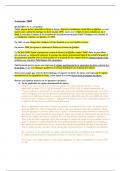2021
English 305: Essay 1
D. H. Lawrence and
“Poetry of the Present”
219006273
KIRSTIN PILLAY
, D.H Lawrence pioneers the genre of poetry known as "Poetry of the Present". "Poetry of the
Present" as a concept encapsulates the dynamic and vigorous nature of the present moment.
To accomplish this, Lawrence necessitates that there must be a deviation from traditional
poetic conventions of rigidness. Instead, free verse and flexibility within poetry should be
used to depict the spontaneity of the present (Lawrence, 1918, p. 1). This essay will discuss
how the concepts of "Poetry of the Present" are illustrated in D. H Lawrence's poems and the
correlations between D. H. Lawrence's poem "Fidelity" and his essay "Poetry of the Present".
As well as discuss the quotation by Van Wyngaard, with reference to "Mountain Lion" and
"Poetry of the Present".
D.H. Lawrence's "Poetry of the Present" is a poetic discourse that disregards the typical
conventions of poetry. This method is not plagued by forethought. It pays no attention to
literary precision and is the fruition of the unconscious mind being allowed to present itself.
The Poet aims to write out of the experience of the unexpected, unrestrained compulsion of
his soul, and as stated by Lawrence, it should be the " direct utterance from the instant, whole
man (Lawrence, 1918, pp.4). The Poet continues to express, "The utterance is like a spasm,
naked contact with all influences at once (Lawrence, 1918, p. 5). Subsequently, the Poet
rejects moulding his work into a faultless piece of art (Oates, 2008, p. 1). Lawrence
disapproves of the inflexible, stagnant and traditional poems of the poetry of the past and
advocates for present tense, unrefined, free verse poems that capture the current moment and
the ever-changing nature of life itself, which is represented in "Poetry of the Present"
(Lawrence, 1918, pp.1).
The principles that D.H. Lawrence sets out in "Poetry of the Present" are exemplified in his
poem "Fidelity". The poem compares the initial, capricious stages of love in a relationship to
the brief life of a flower and the trust that develops gradually during the relationship between
a couple to a seemingly ever-lasting gem (Dix, 2021) . The poem's first stanza states,
"Fidelity and love are two different things, like a flower and a gem. / And love, like a flower,
will fade, will change into something else / or it would not be flowery". The first simile
explored relates to flowers. It equates the transient essence of a flower, wherein its beauty
lies, to the temperamental nature of love in a budding relationship filled with compelling and
1





